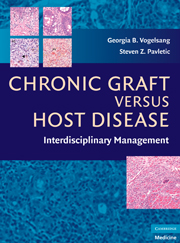Book contents
- Frontmatter
- Contents
- List of Contributors
- Preface
- PART I GENERAL PRINCIPLES
- PART II CLINICAL MANAGEMENT
- PART III ORGAN SITE OR SYSTEM-SPECIFIC MANIFESTATIONS
- 16 Cutaneous Manifestations of Chronic Graft versus Host Disease
- 17 Oral Chronic Graft versus Host Disease
- 18 Chronic Ocular Graft versus Host Disease
- 19 Gynecological Manifestations of Chronic Graft versus Host Disease
- 20 Gastrointestinal and Hepatic Manifestations of Chronic Graft versus Host Disease
- 21 Chronic Graft versus Host Disease and the Lung
- 22 Hematologic Complications of Chronic Graft versus Host Disease
- 23 Neurological Manifestations of Chronic Graft versus Host Disease
- 24 Rehabilitation Evaluation and Treatment of Patients with Chronic Graft versus Host Disease
- 25 Infections
- 26 Endocrine and Metabolic Effects of Chronic Graft versus Host Disease
- 27 Other Manifestations of Chronic Graft versus Host Disease
- 28 Psychosocial Issues in Chronic Graft versus Host Disease
- 29 Secondary Malignancies and Other Late Effects
- 30 Health-Related Quality of Life (HRQOL) in Chronic Graft versus Host Disease
- PART IV SPECIAL CONSIDERATIONS IN CHRONIC GVHD
- Index
- Plate section
22 - Hematologic Complications of Chronic Graft versus Host Disease
from PART III - ORGAN SITE OR SYSTEM-SPECIFIC MANIFESTATIONS
Published online by Cambridge University Press: 26 August 2009
- Frontmatter
- Contents
- List of Contributors
- Preface
- PART I GENERAL PRINCIPLES
- PART II CLINICAL MANAGEMENT
- PART III ORGAN SITE OR SYSTEM-SPECIFIC MANIFESTATIONS
- 16 Cutaneous Manifestations of Chronic Graft versus Host Disease
- 17 Oral Chronic Graft versus Host Disease
- 18 Chronic Ocular Graft versus Host Disease
- 19 Gynecological Manifestations of Chronic Graft versus Host Disease
- 20 Gastrointestinal and Hepatic Manifestations of Chronic Graft versus Host Disease
- 21 Chronic Graft versus Host Disease and the Lung
- 22 Hematologic Complications of Chronic Graft versus Host Disease
- 23 Neurological Manifestations of Chronic Graft versus Host Disease
- 24 Rehabilitation Evaluation and Treatment of Patients with Chronic Graft versus Host Disease
- 25 Infections
- 26 Endocrine and Metabolic Effects of Chronic Graft versus Host Disease
- 27 Other Manifestations of Chronic Graft versus Host Disease
- 28 Psychosocial Issues in Chronic Graft versus Host Disease
- 29 Secondary Malignancies and Other Late Effects
- 30 Health-Related Quality of Life (HRQOL) in Chronic Graft versus Host Disease
- PART IV SPECIAL CONSIDERATIONS IN CHRONIC GVHD
- Index
- Plate section
Summary
Chronic graft versus host disease (GVHD) is a frequent, polymorphous complication of stem cell transplantation, with every organ as a possible target of alloimmune attack. The mechanism of reported hematologic chronic GVHD remains a mystery, since the hematopoietic system after transplantation is donor derived, and therefore, any hematologic chronic GVHD must represent aberrant autoimmunity. Alternatively, since immunologic attack against host-derived tumor cells after transplantation is directed against hematopoietically expressed antigenic elements, chronic GVHD may represent an alloimmune effect aberrantly extended to normal elements of the hematopoietic system, perhaps on the basis of newly expressed shared antigenic epitopes. The disordered homeostatic expansion of lymphocytes after transplant-induced lymphopenia or in the context of chronic GVHD may be the cause of such phenomena.
The hematologic system is only an infrequent target in chronic GVHD, and, more often than not, cytopenias perceived as manifestations of chronic GVHD have alternate explanations. In this chapter, an approach to the patient with hematologic abnormalities after transplantation is reviewed, as are some of the more commonly seen hematologic manifestations of chronic GVHD.
EVALUATION OF THE PATIENT WITH CYTOPENIAS
There are numerous causes to explain single- or multi-lineage cytopenia seen after transplantation, and many of these causes can overlap temporally with the occurrence of chronic GVHD. Table 22.1 lists the many of the more common causes of cytopenias after transplantation. The most ominous causes of cytopenia after transplantation, usually involving all three blood lines are graft failure and/or rejection, with or without malignant disease relapse.
- Type
- Chapter
- Information
- Chronic Graft Versus Host DiseaseInterdisciplinary Management, pp. 238 - 242Publisher: Cambridge University PressPrint publication year: 2009

